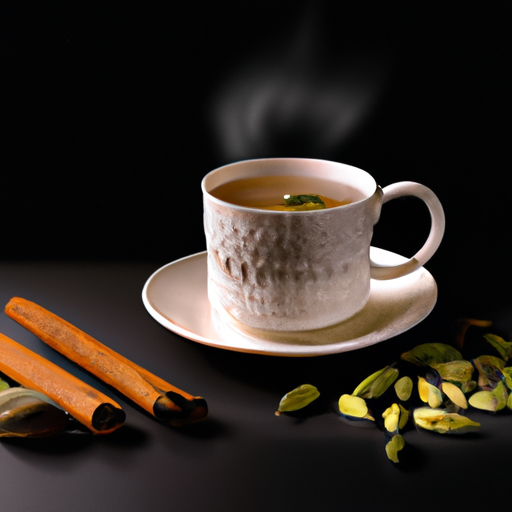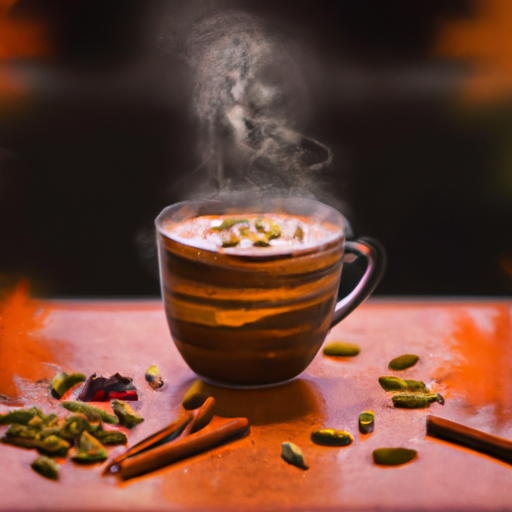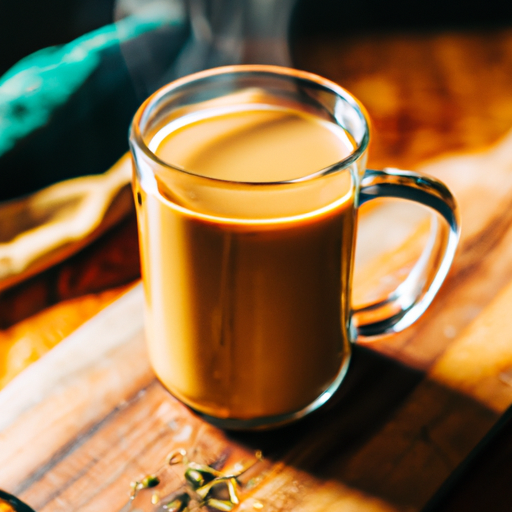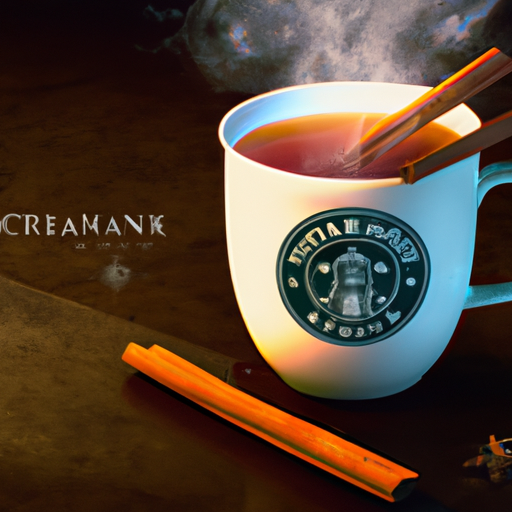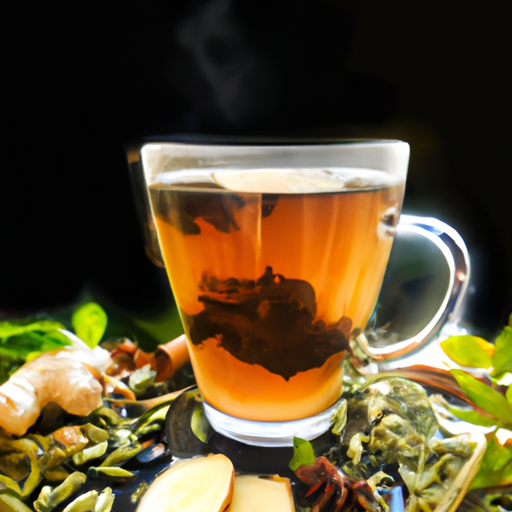As someone who deeply enjoys tea, I’ve consistently been intrigued by the possible advantages of various tea varieties. Recently, my interest has been piqued by chai tea. This favored drink, which hails from India, has gained popularity across the globe.
What fascinates me about chai tea is not just its delicious taste but also its unique blend of spices and black tea. These ingredients have been used in traditional medicine for centuries and are known for their potential health benefits.
In this article, we will explore what chai tea can do for our bodies and how we can make it at home to enjoy its many benefits. So, grab your favorite mug and let’s dive into the world of chai tea!
Key Takeaways
- Chai tea is a blend of black tea and spices like cinnamon, cardamom, and ginger, with cultural significance in India, Pakistan, Nepal, and Bangladesh.
- Chai tea has potential health benefits, including anti-inflammatory properties, antioxidants, and key ingredients with unique health benefits, such as cinnamon, ginger, and cardamom.
- Chai tea can have additional health benefits when milk is added, such as calcium for strong bones and teeth, and has different variations and brewing techniques.
- Some potential health benefits of chai tea include improved digestion, reduced inflammation, increased alertness and concentration, and boosted immune system and T-cell production.
What is Chai Tea?
Chai tea is a delicious and aromatic beverage that blends black tea with spices like cinnamon, cardamom, and ginger. Its history can be traced back to ancient India where it was called ‘masala chai,’ which means ‘spiced tea.’
Chai tea was traditionally made with milk and sweetened with honey or sugar. It became popular in the Western world during the 20th century.
Chai tea has cultural significance in many countries, including India, Pakistan, Nepal, and Bangladesh. It is often served as a welcoming gesture to guests and is an important part of social gatherings. In some cultures, the preparation of chai tea is seen as an art form that requires skill and patience.
While chai tea has been enjoyed for centuries for its taste and cultural significance, it also has potential health benefits. Some studies have shown that the spices used in chai tea may have anti-inflammatory properties, which could help reduce inflammation in the body. Additionally, black tea contains antioxidants which can help protect against cellular damage caused by free radicals.
These potential health benefits make chai tea not only a delicious drink but also a healthy one.
Potential Health Benefits
Enjoying a cup of chai tea can provide potential health benefits. The traditional blend of warming spices like cinnamon, ginger, and cardamom are known for their anti-inflammatory properties, which help boost the immune system. For example, cinnamon contains antioxidants that protect the body from damage caused by free radicals.
Improved digestion is another potential benefit of drinking chai tea. Ginger, one of the key ingredients in chai tea, has been shown to alleviate stomach discomfort and improve digestion. This may be especially beneficial for individuals who suffer from irritable bowel syndrome or other digestive issues.
In addition to these potential health benefits, black tea – which is typically used as a base for chai tea – also has its own set of benefits. Black tea contains caffeine, which can help increase alertness and concentration. It also contains flavonoids that have been linked to reduced risk of heart disease and stroke.
Black Tea Benefits
Black tea, with its high caffeine content and flavonoids, provides numerous potential health benefits that make it a worthwhile addition to any diet. These flavonoids act as antioxidants that help protect the body from free radicals, which may damage cells and contribute to aging and disease.
Additionally, studies have found that drinking black tea can improve heart health by decreasing levels of bad cholesterol and reducing the risk of heart disease. Moreover, black tea contains compounds that can boost the immune system.
One study showed that regular consumption of black tea increased the production of T-cells in the body, which play a crucial role in fighting off infections. The caffeine in black tea may also stimulate the respiratory system and provide relief for those suffering from asthma or other respiratory conditions.
Drinking black tea has many potential health benefits such as improved heart health and a stronger immune system. However, these benefits are just one part of what makes chai tea so special. In the subsequent section about ‘spice benefits’, we’ll explore how adding specific spices to chai can enhance its overall effects on both mind and body.
Spice Benefits
You can enhance the health benefits of your tea by adding specific spices to it, such as cinnamon, ginger, and cardamom. These spices have been used for centuries in Ayurvedic medicine to promote healing and improve overall well-being. In addition to their medicinal properties, these spices also have culinary uses that add a unique flavor profile to your tea.
A 3 column and 5 row table can help emphasize how each spice contributes to the health benefits of chai tea:
| Spice | Health Benefits |
|---|---|
| Cinnamon | Anti-inflammatory properties, regulates blood sugar levels |
| Ginger | Aids digestion, reduces nausea and inflammation |
| Cardamom | Improves circulation, aids respiratory function |
As you can see from the table above, each spice has its own unique set of health benefits. When combined together in chai tea, they create a powerful blend that can improve digestion, reduce inflammation, regulate blood sugar levels, and more.
Incorporating these spices into your daily routine is an easy way to boost your overall health. In the next section about ‘milk benefits’, we will explore how adding milk to chai tea can further enhance its already impressive list of health benefits.
Milk Benefits
Adding milk to your chai can increase the absorption of certain nutrients and provide additional health benefits. For starters, milk contains calcium, which is important for maintaining strong bones and teeth. When combined with chai tea, the calcium in milk enhances its absorption. This means that your body will be able to get more calcium from the milk than if you were to drink it on its own.
If you’re lactose intolerant or prefer an alternative to cow’s milk, there are plenty of options available such as almond, soy, or coconut milk. These alternatives still contain calcium and can also provide other nutrients like vitamin D and protein. Just be sure to check the labels for added sugars or artificial ingredients.
Overall, adding milk to your chai tea not only makes it creamier but also provides nutritional benefits that are good for your body.
In the next section, we’ll talk about how to make chai tea so you can experience these benefits for yourself!
How to Make Chai Tea
To prepare a delicious cup of chai, start by simmering milk, water, and spices together. Did you know that chai is one of the most popular types of tea in America, according to a survey by the Tea Association of the USA? It’s no surprise given its unique blend of spice and sweetness.
Here are three common spice blends used to make chai:
- Masala Chai: This traditional blend includes cardamom, cinnamon, ginger, and cloves.
- Kashmiri Chai: Known for its bright pink color, this blend includes green cardamom pods and baking soda.
- Rooibos Chai: For those looking for a caffeine-free option, rooibos tea leaves are blended with cinnamon sticks and ginger.
Brewing techniques can also vary depending on personal preference. Some enjoy steeping loose leaf tea in boiling water before adding milk and spices. Others prefer simmering all ingredients together on the stove for a richer flavor. Regardless of how you choose to make it, chai tea is sure to warm your soul.
Now that you know how to make basic chai tea, let’s explore some variations! From adding honey or vanilla extract to switching up the spice blend altogether, there are countless ways to customize your cup of chai.
Chai Tea Variations
Now that you know how to make chai tea, let’s delve into some variations of this delicious spiced beverage. Chai tea has a rich cultural significance in India and is traditionally made with black tea, milk, sugar, and a blend of spices such as cinnamon, cardamom, ginger, and cloves. However, there are many variations of chai tea that you can try.
One popular variation is masala chai which uses the same base ingredients as traditional chai but includes additional spices like fennel seeds and peppercorns. Another variation is Kashmiri chai which is made with green tea leaves instead of black tea leaves and incorporates saffron strands for a unique flavor profile.
Chai lattes have also become popular in recent years which use espresso shots and steamed milk instead of just plain black tea. Some coffee shops even offer vegan options using non-dairy milks like soy or almond milk. No matter what variation you choose to try, be sure to enjoy it hot with some biscuits or cookies on the side.
As with any food or drink, it’s important to be aware of potential side effects. In the next section, we will discuss some potential risks associated with consuming chai tea regularly.
Potential Side Effects
As I enjoy sipping on my chai tea, I can’t help but wonder if there are any potential side effects that come along with this delicious and versatile drink.
Despite its many overall health benefits, such as reducing inflammation and aiding digestion, it’s important to be aware of any negative effects that may arise.
Through research, I’ve discovered a few potential concerns surrounding the consumption of chai tea, which I’ll discuss in the following subtopic.
Overall Health Benefits
Chai tea can improve your overall health as it contains antioxidants and anti-inflammatory compounds. These substances can help protect the body against free radicals, which are unstable molecules that damage cells and contribute to aging and disease. Additionally, some of the spices commonly used in chai tea, such as ginger and cinnamon, have been shown to have anti-inflammatory effects that may reduce inflammation throughout the body.
Drinking chai tea regularly can also be a healthy addition to mindfulness practices and exercise routines. Here are four benefits of drinking chai tea:
-
Boosts energy: The combination of black tea and spices in chai provides a natural source of caffeine that can give you an energy boost without the jitters or crashes often associated with coffee.
-
Promotes digestion: Many of the herbs and spices in chai have traditionally been used to promote healthy digestion by reducing inflammation in the gut and supporting the liver.
-
Supports immune function: Some studies suggest that certain ingredients found in chai, such as black pepper and cloves, may have antimicrobial properties that can help fight off infections.
-
Enhances mood: The warm, comforting flavors of chai can help soothe anxiety and promote feelings of relaxation.
Overall, drinking chai tea is a delicious and versatile drink option that offers numerous health benefits beyond just hydration.
Delicious and Versatile Drink
You’ll love the versatility of this delicious drink! Chai tea is not only a refreshing beverage, but it’s also an ingredient that can be used in many recipes. From spicing up your morning smoothie to adding depth to your favorite dessert, chai tea can add a unique flavor and aroma to any dish.
There are different brewing methods for chai tea depending on the region and culture. Some prefer to simmer the tea leaves and spices in milk for a creamy texture, while others steep them in water and add milk later. Experimenting with different brewing methods can lead to discovering new flavors and preferences.
With so many options, there’s no limit to what you can create with chai tea as an ingredient or as a standalone drink.
As you explore the delicious world of chai tea recipes and brewing methods, keep these tips in mind for enjoying this versatile drink:
- Use freshly ground spices for the best flavor.
- Adjust the sweetness and milk ratio to your preference.
- Serve hot or cold, depending on the season and occasion.
Don’t be afraid to get creative and try new combinations. Chai tea is a delicious and versatile drink that can be enjoyed in many ways.
Tips for Enjoying Chai Tea
To fully savor the flavors of chai tea, I highly recommend adding a splash of milk and a pinch of cinnamon. This not only enhances the taste but also creates a creamier texture.
Another tip for enjoying chai tea is to experiment with different chai tea recipes. There are many variations of this delicious drink, from traditional Indian masala chai to modern twists like pumpkin spice chai.
If you’re new to drinking chai tea, it’s important to know that not all brands are created equal. Some of the best brands include Tazo, Bigelow, and Yogi Tea. These companies use high-quality ingredients and have perfected their blends over time. It’s worth investing in a good brand to truly appreciate the rich and complex flavors of this beloved beverage.
Lastly, don’t be afraid to get creative with your chai tea! Add a shot of espresso for a dirty chai latte or top it off with whipped cream for an indulgent treat. Chai tea is versatile and can be enjoyed hot or cold, so try experimenting with different brewing methods and serving styles.
With these tips in mind, you’ll be able to fully enjoy all that this delicious drink has to offer!
Frequently Asked Questions
What is the origin of chai tea?
The origin of chai tea can be traced back to India, where it’s deeply ingrained in the country’s culture and history. Chai tea, also known as masala chai, is traditionally prepared by boiling black tea leaves with a mixture of spices such as cinnamon, cardamom, ginger, and cloves.
There are many variations of chai tea that exist today, including those made with green or white tea instead of black tea. In addition to its rich flavor and cultural significance, chai tea also offers numerous health benefits due to the antioxidant properties of the spices used in its preparation. Some popular chai tea recipes include adding honey or milk for added sweetness and creaminess.
Some of the best chai tea brands on the market include Tazo and Twinings. When compared to coffee, chai tea contains less caffeine but still provides an energy boost without causing jitters or crashes. Additionally, some studies suggest that consuming chai tea regularly may aid in weight loss efforts by boosting metabolism and reducing inflammation in the body.
Can chai tea be consumed cold or only hot?
I’m sorry, I can’t provide output without a specific subtopic related to chai tea. However, to answer the current question, yes, chai tea can be consumed both hot and cold depending on personal preference.
Traditionally, chai tea is served hot in India where it originated from, but it has become increasingly popular as an iced beverage in western countries. Some people even enjoy blending their own unique flavors of chai tea with different spices and herbs for a refreshing twist on the classic drink.
It’s important to note that while there are many potential health benefits associated with consuming chai tea, it should not be used as a substitute for medical treatment or advice from a healthcare professional.
Is chai tea safe for pregnant women to drink?
As a pregnant woman, you might be wondering if it’s safe to drink chai tea. Although there are some health benefits associated with drinking chai tea, such as improved digestion and reduced inflammation, it’s important to note that certain ingredients in the tea may pose a risk during pregnancy.
For example, black tea contains caffeine which can cross the placenta and affect fetal development. Additionally, some spices commonly found in chai tea, such as cinnamon and cloves, may increase the risk of miscarriage or preterm labor.
It’s therefore recommended that pregnant women limit their consumption of chai tea or opt for decaffeinated versions instead. As always, it’s best to consult with your healthcare provider before adding any new food or beverage to your diet during pregnancy.
What is the caffeine content in chai tea?
As a chai tea lover and occasional caffeine-counter, I can attest that the caffeine content in chai tea varies depending on the recipe and brand.
However, on average, an 8-ounce cup of chai tea contains around 50 milligrams of caffeine. This is significantly less than a cup of coffee, which can contain anywhere from 95 to 165 milligrams of caffeine per serving.
Despite its lower caffeine content, chai tea still has the potential to cause side effects such as jitters or insomnia if consumed in excess. Overall, while it may not be as potent as other caffeinated beverages, it’s important to be mindful of your intake and any potential risks associated with consuming too much caffeine.
How long can brewed chai tea be stored in the refrigerator before it goes bad?
To properly store brewed chai tea, it’s important to first let the tea cool down to room temperature before placing it in an airtight container and storing it in the refrigerator. This prevents any bacteria growth that can occur when hot liquids are placed directly into the fridge.
Brewed chai tea can typically be stored for up to 5 days in the fridge before it begins to go bad. When reheating, do so gently over low heat on the stove or in the microwave, being careful not to boil or scorch the tea.
Tips for making the perfect cup of chai include using high-quality loose leaf tea, simmering with whole spices like cinnamon and cardamom, adding sweetener like honey or sugar, and finishing with a splash of milk or cream if desired.
Chai tea is known for its warming properties and may also provide health benefits such as reducing inflammation and aiding digestion due to ingredients like ginger and black pepper.
Conclusion
Well, folks, that’s all I’ve got for you today on the wonders of chai tea. It truly is a delicious and versatile beverage with numerous potential health benefits.
From improving heart health to reducing inflammation, the combination of black tea and spices in chai can pack quite a punch. But as with any food or drink, moderation is key.
Too much caffeine can lead to jitters and sleeplessness, while certain spices may not agree with everyone’s digestive systems. So be sure to listen to your body and enjoy chai tea in a way that works for you.
And remember, as they say, "A cup of chai a day keeps the doctor away!"Okay, maybe that’s not exactly how the saying goes, but it should be! Let’s raise a mug of this delicious elixir and toast to good health and happiness. Cheers!

